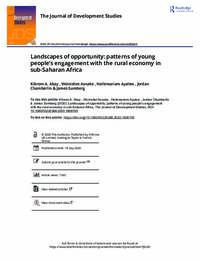Landscapes of opportunity: patterns of young people’s engagement with the rural economy in sub-Saharan Africa

Authors:
While much has been said in recent years about the importance of engaging rural youth in subSaharan Africa’s development, the factual data about how African youth currently engage in rural economies
remain sparse. We use recent nationally representative household survey data from six countries to describe the patterns of such engagement. We find that young people participate in agriculture at similar rates to older people. However, participation in non-farm wage employment and business activity changes with age, peaking in the 30s. The likelihood of reporting no activity is greatest for people in their 20s. In more remote places, people leave school earlier and are less likely to engage in the non-farm sector, compared with people in more accessible places. We also find evidence that the non-farm economy is more diversified in relatively more accessible places, offering a larger set of options for economic engagement. We show that ‘landscapes of opportunity’ , defined by economic remoteness and agricultural potential, are an important way of assessing the choices available to young rural people. A key conclusion is that efforts to develop a ‘youth lens’ for rural development should not abandon the mainstays of rural investment strategies such as infrastructure, education, and agricultural R&D.
